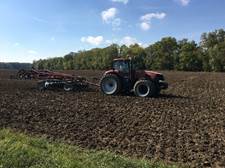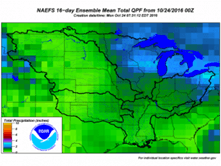Good afternoon,
I hope that you had a good Thanksgiving and had time to spend it with family and those who are close to you. We are thankful for a completed harvest, one which corn yields may not have been where we wanted them to be, but most likely better than expected. The soybean crop did turn out much better than once predicted, which was good news to area farmers given some of corn yields that were disappointing. We were able to harvest all of our OSU Extension test plots, but I have been busy working on winter program planning and the upcoming Hardin County Agriculture Hall of Fame Banquet so I don’t have further information to share at this time. This year Stephanie Jolliff, Wright McCullough, Bruce McPheron, and Mark Rose will be inducted into the 2016 class. Have you reserved your tickets yet? If not, you need to call the Extension office as soon as possible so we can hold tickets for you at the door. You may have already read about those being honored on Tuesday, December 6, but if not, I have attached a copy of the news article that was sent to local media.
2016 Ag Hall of Fame News Release
Other local upcoming events include Ag Council on Friday, December 2 starting at 7:00 am at Henry’s Restaurant, Hardin County Fairboard on Saturday, December 3 starting at 7:30 pm at the fair office, and a Farm Bureau meeting on Monday, December 5 starting at 7:00 pm at Ag Credit. Since the last edition of the Hardin County Agriculture and Natural Resources Update came out, I was able to participate in a Blanchard River Demonstration Farms Tour of Hancock and Hardin Counties. On this tour, our group was able to visit the Kurt Farm in Dunkirk, the Kellogg Farm in Forest, and the Stateler Farm in McComb to see research that is being conducted to test conservation and nutrient management practices and their effect on water quality in the Western Lake Erie Basin. I also had the opportunity to speak to the Ottawa River Coalition in Lima on this same topic.
Do you have a plan for marketing your grain that is in the bin? Would you like to brush up on your grain marketing skills? Auglaize County Extension is hosting a Grain Marketing workshop called ‘Turning On-Farm Storage into a Profit.’ The date for this program is December 7 with a deadline for registration on December 2. See the attached flyer for more information about this event that will include topics such as: How on-farm storage combined with forward selling, market carry, and basis appreciation can provide added income; Hedging with futures to reduce risk; and How options can be a great addition to a farmer’s marketing tool box. Below are some agronomy related articles that you may be interested in reading.
Mark
The XtendiMax Label for Xtend Soybeans – Mark Loux, Bill Johnson
As everyone has probably heard by now, there is finally a federal label for the use of a dicamba product, XtendiMax, on dicamba-resistant (Xtend) soybeans, such as it may be. We cover some of the highlights from the label here and in part II, some additional thoughts on what it all means. The XtendiMax is based on dicamba DGA (Clarity), and the formulation contains “Vapor Grip” (imagine a deep voice with reverb), which reduces the volatility of the dicamba spray mix. It’s a 2.9 lb/gallon liquid, so 22 oz provides 0.5 lb of dicamba, which is equivalent to 16 oz of Clarity and other 4 lb/gallon dicamba products. To learn more about the XtendiMax Label for Xtend Soybeans, go to http://agcrops.osu.edu/newsletter/corn-newsletter/2016-38/xtendimax-label-xtend-soybeans.
2016 Ohio Corn Performance Test Results Now Available On-Line – Rich Minyo, Peter Thomison, Allen Geyer
The purpose of the Ohio Corn Performance Test is to evaluate corn hybrids for grain yield and other important agronomic characteristics. Results of the test can assist farmers in selecting hybrids best suited to their farming operations and production environments. Corn hybrids differ considerably in yield potential, standability, maturity, and other agronomic characteristics that affect profitable crop production. Hybrid selection should be based on proven performance from multiple test locations and years. Single and multi-year agronomic data is available for all sites and regions for 2016. Go to http://agcrops.osu.edu/newsletter/corn-newsletter/2016-38/2016-ohio-corn-performance-test-results-now-available-line to get more 2016 Ohio Corn Performance Tests information.
When is it Time for a No-till Field to be Tilled? – Anne Dorrance, Laura Lindsey, Peter Thomison, Andy Michel, Mark Loux
Tillage is a tool for managing many things that can go wrong on a given field. It breaks compaction (if done at the right soil moisture), improves drainage (again if done at the right soil moisture), and manages inoculum loads from residue borne insects and pathogens that impact corn, soybean, and wheat. Just like pesticides and fertilizers – too much tillage also can bring another set of problems, a compacted plow layer, but more importantly, soil erosion. With any agronomic practice, including tillage, there are benefits and drawbacks. Go to http://agcrops.osu.edu/newsletter/corn-newsletter/2016-38/when-it-time-no-till-field-be-tilled to read more about using tillage as a method of dealing with pathogens, insects, and weeds.
2016 Grain is in the Bin – What Should I Watch for? – Bruce Clevenger, Curtis Young
There are many reasons why on-farm grain storage is used by producers across Ohio. It may be part of the marketing strategy, feed storage for farm use, and/or income and tax management to complete grain sales before and/or after the new calendar year. Regardless of the reason, an essential requirement is to maintain quality grain during the storage period to preserve the grain for end usage and economic value. 2016 presented some grain quality challenges, especially for corn so it will be important to manage the grain during the next several months. Go to http://agcrops.osu.edu/newsletter/corn-newsletter/2016-38/2016-grain-bin-what-should-i-watch to read more tips about maintaining grain quality while storing grain in bins.
The Certified Crop Adviser – Harold D. Watters
The Certified Crop Adviser (CCA) and Certified Professional Agronomist (CPAg) programs of the American Society of Agronomy are the benchmarks of professionalism. The CCA certification was established in 1992 to provide a benchmark for practicing agronomy professionals in the United States and Canada. The Ohio CCA program has been operating since 1994; a local board directs our program and is managed by the Ohio AgriBusiness Association: http://oaba.net/aws/OABA/pt/sp/cca. Certification is the standard by which professionals are judged. The purpose of a certification program is to protect the public and the profession. To find out more about CCAs and how to become certified, go to http://agcrops.osu.edu/newsletter/corn-newsletter/2016-37/certified-crop-adviser.
Mark A. Badertscher
Agriculture and Natural Resources Educator
OSU Extension Hardin County
1021 W. Lima Street, Suite 103, Kenton, OH 43326
419-674-2297 Office















